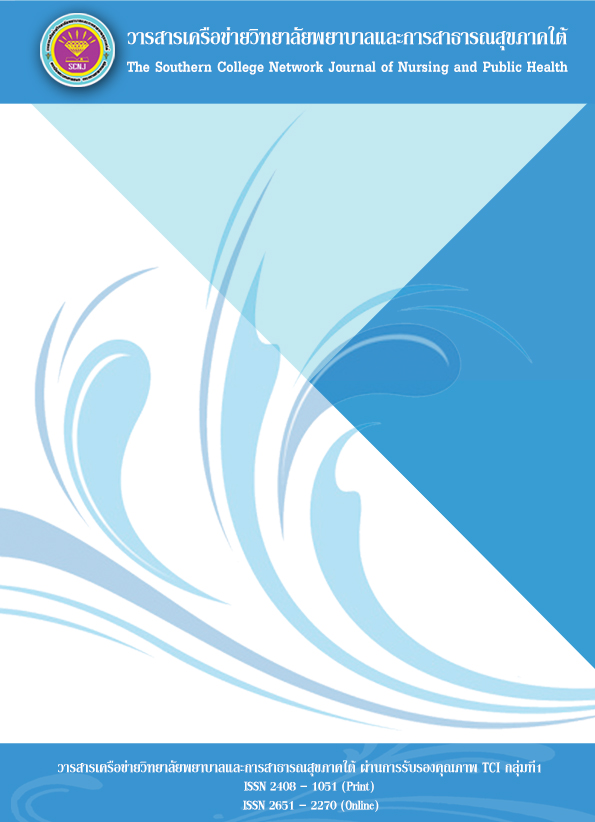โมเดลสมการโครงสร้างพฤติกรรมสุขภาพตามบทสุขบัญญัติแห่งชาติ ของนักเรียนประถมศึกษาปีที่ 5 โรงเรียนประถมศึกษาในอำเภอเมือง จังหวัดยะลา
คำสำคัญ:
โมเดลสมการโครงสร้างพฤติกรรมสุขภาพตามสุขบัญญัติแห่งชาติ, ปัจจัยเสริม, ปัจจัยเอื้อบทคัดย่อ
การวิจัยเชิงสหสัมพันธ์และเชิงสาเหตุนี้ มีวัตถุประสงค์เพื่อศึกษาความสัมพันธ์เชิงสาเหตุของปัจจัยที่มีอิทธิพลต่อพฤติกรรมสุขภาพตามสุขบัญญัติแห่งชาติของนักเรียนชั้นประถมศึกษาปีที่ 5 โรงเรียนประถมศึกษาในเขตอำเภอเมือง จังหวัดยะลา จำนวน 124 คน โดยประยุกต์ใช้ระยะที่ 3 ของทฤษฎีแบบจำลองการวางแผนสุขภาพ (PRECEDE-PROCEED Model) ใช้วิธีสุ่มตัวอย่างแบบหลายขั้นตอน เก็บรวบรวมข้อมูลโดยใช้แบบสอบถามผ่านการตรวจหาความตรงด้านเนื้อหาได้ค่า IOC มากกว่า 0.50 ทุกข้อ และหาค่าความเชื่อมั่นด้วยวิธีหาสัมประสิทธิ์แอลฟาของครอนบาค ได้ค่าความเชื่อมั่นปัจจัยเสริม ค่าความเชื่อมั่นเท่ากับ .89 การได้รับการดูแลเอาใจใส่จากผู้ปกครองมีค่าความเชื่อมั่นเท่ากับ .90 การได้รับการดูแลเอาใจใส่จากครูมีค่าความเชื่อมั่นเท่ากับ .92 ปัจจัยเอื้อค่าความเชื่อมั่น เท่ากับ .71 สภาพแวดล้อมทางกายภาพที่โรงเรียน เท่ากับ .71 สภาพแวดล้อมทางกายภาพที่บ้าน เท่ากับ .70 และ พฤติกรรมสุขภาพตามสุขบัญญัติแห่งชาติ มีค่าความเชื่อมั่นเท่ากับ .89 สถิติที่ใช้คือเทคนิคการวิเคราะห์ความสัมพันธ์เชิงสาเหตุด้วยโมเดลสมการโครงสร้างกำลังสองน้อยที่สุดบางส่วน (A Partial Least Square Structural Equation Modeling) ผลการวิจัยพบว่า
ตัวแปรสังเกตได้การได้รับดูแลเอาใจใส่จากผู้ปกครอง (Loading=0.94) และการได้รับการดูแลเอาใจใส่จากครู (Loading=0.84) มีอิทธิพลกับพฤติกรรมสุขภาพตามสุขบัญญัติแห่งชาติผ่านตัวแปรแฝงภายนอกปัจจัยเสริมอย่างมีนัยสำคัญทางสถิติที่ระดับ .01 (β=0.29, t=3.48, p-value<0.00) และตัวแปรสังเกตได้ปัจจัยเสริม สิ่งแวดล้อมทางกายภาพที่บ้าน (Loading=0.899) และสิ่งแวดล้อมทางกายภาพที่โรงเรียน (Loading=0.886) มีอิทธิพลต่อพฤติกรรมสุขภาพตามสุขบัญญัติแห่งชาติผ่านตัวแปรแฝงภายนอกปัจจัยเอื้ออย่างมีนัยสำคัญทางสถิติที่ระดับ .01 (β=0.45, t=4.72, p-value<0.00) โมเดลสมการโครงสร้างตามการประยุกต์ใช้ทฤษฎีนี้สามารถอธิบายความแปรปรวนของพฤติกรรมสุขภาพตามสุขบัญญัติแห่งชาติได้ร้อยละ 41.00 (R2=0.41) ซึ่งอยู่ในระดับปานกลาง
ดังนั้นผู้ ปกครองและครูควรดูแลเอาใจใส่นักเรียนในด้านสุขภาพอนามัยส่วนบุคคล รวมถึงจัดสภาพแวดล้อมทางกายภาพที่บ้านและโรงเรียน ให้เอื้ออำนวยต่อการปฏิบัติพฤติกรรมสุขภาพของนักเรียน และหน่วยงานด้านสาธารณสุขควรเข้ามาส่งเสริมปัจจัยเสริมและปัจจัยเอื้อต่อการเกิดพฤติกรรมสุขภาพตามสุขบัญญัติแห่งชาติ ของนักเรียนเพื่อให้นักเรียนมีสุขภาพที่ดีต่อไป
เอกสารอ้างอิง
Gomes, A. R., & Capelão, T. (2012). Predicting Exercise Behavior: Testing Personal and Psychological Variables. International Journal of Sports Science, 2(5), 45-50.
Green, & Kreuter, M. (2005). Health Promotion Planning: an Educational and Ecological Approach. Retrieved March 5, 2017 from https://ctb.ku.edu/en/tablecontents/overview/other-models-promoting-community-health-anddevelopment/preceder-proceder/main.
Hair, J. F., Hult, G. T. M., Ringle, C. M., & Sarstedt, M. (2014). A Primer on Partial Least Squares Structural Equation Modeling (PLS-SEM). Thousand Oaks, CA: Sage.
Health Education Division, Department of Health Service Support Ministry of Public Health. (2009). Health Behaviors Assessment Followed the National Health Recommendations of Students in the Academic Year 2009. Bangkok. (in Thai)
Health Education Division, Department of Health Service Support Ministry of Public Health. (2009). Health Behaviors Report Followed the National Health Recommendations. Bangkok. (in Thai)
Health Education Division, Department of Health Service Support Ministry of Public Health. (2011). Additional Health Behaviors Followed National Health Recommendations. Nontaburi: Ministry of Public Health. (in Thai)
Health Education Division, Ministry of Public Health. (2009). Additional Guidelines Health Behaviors Recommendations in Academy. Nontaburi: Ministry of Public Health.
Health Education Division, Ministry of Public Health. (2010). National Health Recommendations. Nontaburi: Ministry of Public Health. (in Thai)
Jaidee, C. (2015). Factor Affecting Health Behaviors on the National Health Recommendations of Student in the Institute of Physical Education Yala Campus. Journal of Faculty of Physical Education, 7(2), 145-158 (in Thai)
Janturos, P. (2016). Self-Health Care Behavior of Prothomsuksa Five-Six Students Under the Responsibility of Education Service Area Zone One. A Dissertation Submitted in Partial of the Requirement for the Master of Education for Health Promotion, Prince of Songkhla University. (in Thai)
Keawbut, P., Tammacharean, R., & Kotcharat, J. (2018). The Relationship Between the Learning Organization and the Effectiveness of General Education in Private Schools in Songkhla Province. The Southern College Network Journal of Nursing and Public Health, 1(1), 1-14. (in Thai)
Ministry of Culture. (2016). Around 1 in 3 Children sit on the Screen Over 3 hours Per Day. Retrieved October, 2016 from https://www.mculture.go.th.
Paowattana, A. (2012). Health Promotion and Disease Prevention in the Community: Application of Concepts and Theories to Practice. 2nd. Klungnana Printinghouse: Bangkok. (in Thai)
Prompachak, S. (2013). Health Behaviors 4th-6th Grade 6 Students According to National Health Recommendations at Banrantadpom School, Songpeenong Subdistrict, Thasae District in Chumphorn Province. A Dissertation Submitted in Partial of the Requirement for the Master of Science in Public Health, Phetchaburi Rajabhat University. (in Thai)
Ringle, C. M., Wende, S., & Will, A. (2005). SmartPLS 2.0. M3. Hamburg: Smart PLS. Retrieved March 5, 2017 from https://www.smartpls.de.
Sahamethapat, N. (2014). Health News: Revealing the Inflecting of the Head. Health Service Support Office Fund. Retrieved September 20, 2016 from https://www.thaihealth.or.th /Content/26128.html
Songchai, A. (2014). Factors Correlated with Behaviors Compliance of the National Health Recommendations of Lower Secondary School, Ubonratchathani. A Dissertation Submitted in Partial of the Requirement for the Master of Public Health, Ubonratchathani Rajabhat University. (in Thai)
Thai Health Promotion Foundation. (2014). Exercise on the World Health Day. Health Articles. Retrieved October 1, 2016 from https://thaihealth.or.th/content/23721.html
Thongdee, T. (2002). Factor Associated With Self-care Behavior with Regard to National Health Recommendations among Grade 6 Students Under Local Government Nontaburi Province. A Dissertation Submitted in Partial Fulfillment of the Requirement for Master Science of Health Education, Kasetsart University. (in Thai)
Trirungworarat, B. (2014). The Results of Thai Children’s Health Care Research are Less Concerned with Eating. Thairat Newspaper. May 28, 2014. (in Thai)
Winter, H. R. (2015). Thai Children Wear Helmets “Just 7%”. Retrieved September 14, 2016 from https://manager.co.th/ASTVWeedend/ViewNews.
Worapongsatonn, S. (2015). PRECEDE - PRECEED Model. National Health Education Conference 17th. May 16, 2015. (in Thai)
Yala Primary Education Service Area Office. (2016). Basic Report of Education Academy Early Years Education: 2016. Data Education. Retrieved November 1, 2016 from https://portal.bopp-obec.in/obec59/.
ดาวน์โหลด
เผยแพร่แล้ว
ฉบับ
ประเภทบทความ
สัญญาอนุญาต
1. บทความหรือข้อคิดเห็นใด ๆ ที่ปรากฏในวารสารเครือข่าย วิทยาลัยพยาบาลและการสาธารณสุขภาคใต้ ที่เป็นวรรณกรรมของผู้เขียน บรรณาธิการหรือเครือข่ายวิทยาลัยพยาบาลและวิทยาลัยการสาธารณสุขภาคใต้ ไม่จำเป็นต้องเห็นด้วย
2. บทความที่ได้รับการตีพิมพ์ถือเป็นลิขสิทธิ์ของ วารสารเครือข่ายวิทยาลัยพยาบาลและการสาธารณสุขภาคใต้








